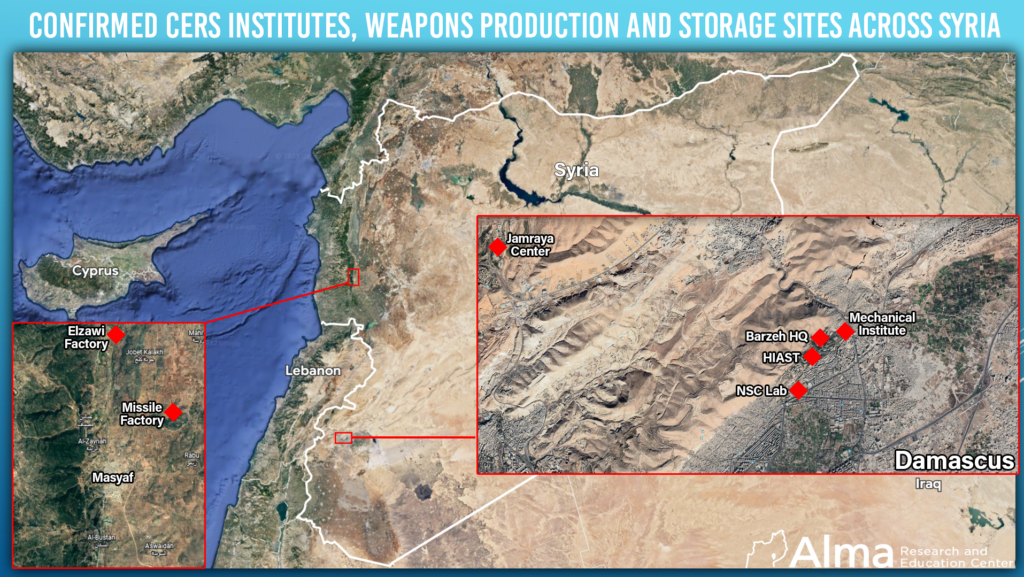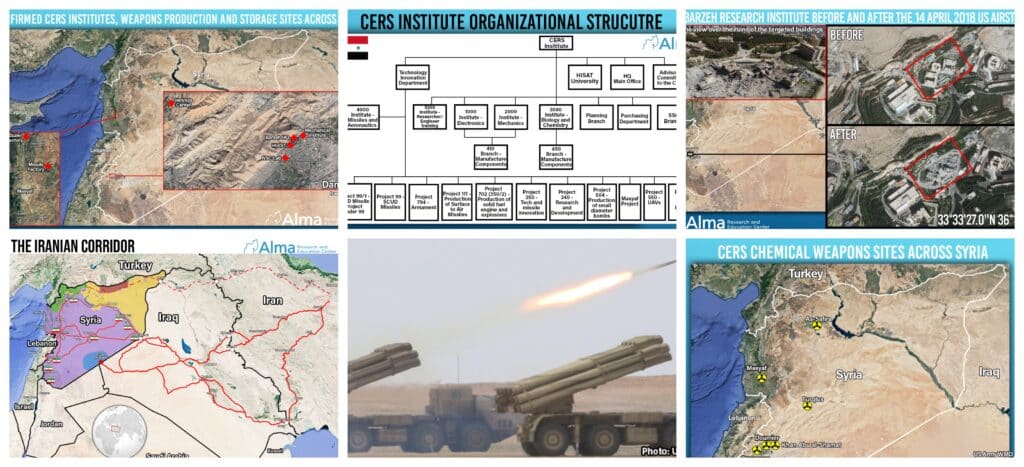The Risk of Chemical or Advanced Weapons Ending up in the Hands of the Iranian Axis Proxies
Special Report By: Tal Beeri & Teddy Sapir.
General – CERS Center and Its Importance
CERS center, established in Syria in 1971, is the Scientific Studies and Research Center (SSRC), or in its French name: the Centre D’Etudes et de Recherches Scientifiques (CERS). The center is a Syrian governmental organization whose declared goal is promoting, directing, and coordinating scientific activities in Syria.
The CERS Center employs around 20,000 people. The majority of the center’s personnel are Syrian researchers, engineers, and military officers of various specialties. The facilities of the center are spread across Syria and comprise a variety of institutes, factories, industrial and storage sites.
The CERS Center serves as Syria’s national military industry. According to numerous studies and publications in the press, research institutes, and reports from intelligence agencies around the world over the years, the CERS Center is accountable for the research, development, and military production of advanced weapons such as surface-to-surface missiles (such as the M-600 / Fateh-110 missile, which is at the heart of the joint Iranian-Syrian and Hezbollah precision project), and it is even possible that the CERS Center is a partner in the “Labaik” project. In addition, the CERS Center is responsible for developing and manufacturing chemical, biological, and potentially nuclear weapons.
Furthermore, the CERS Center produces unique (but not necessarily advanced) weaponry such as barrel bombs and Al-Burkan rockets (barrel bombs mounted on a rocket). These weapons were deployed as conventional destructive weapons against resistance forces and civilian population centers in which they operated. Furthermore, the CERS Center produces basic and standard combat equipment such as helmets and combat vests.
The CERS Center is also defined as one that conducts economic, social, and industrial research and development. The center is in charge of computerization and technological equipment at Syrian universities and government departments, among other things.
According to Iran’s foresee, the CERS Center is envisioned as a “growth engine” for the development and production of modern conventional weapons based on Iranian technology on Syrian soil. Furthermore, the CERS Center operation shortens and saves the logistics of transferring weapons from Iran, which is more vulnerable to harm/disruption and obstruction.
Iran’s major focus is to develop and manufacture precision missiles and rockets, cruise missiles, and unmanned aerial vehicles (UAVs) on Syrian soil, using the CERS Center’s Institute 4000 infrastructure.
The Syrian regime defines CERS as one of the most sensitive security bodies, if not the most sensitive. Since its foundation, the regime has maintained a high level of security monitoring over the CERS Center’s operations and employees. Since the onset of the civil war and the turning of the CERS Center into a kind of joint Syrian-Iranian-Hezbollah platform, security monitoring has been intensified by the Quds Force and Hezbollah’s security unit in Syria, Unit 9000. The Iranians’ involvement grew and extended in all of the CERS Center’s missions until it took control and monitored everything that transpired there. Certain initiatives, particularly those at Institute 4000 (Sector 4), are currently under direct Iranian supervision by senior IRGC Quds Force officers.
The bottom line is that the CERS Center is an inseparable part of the infrastructure of the arms corridor to Syria and Lebanon, both in terms of the production of advanced weapons and their long-term storage for future use by the Shiite axis, as well as their storage in interim storage before transfer to Hezbollah in Lebanon. The CERS Center installations function as Hezbollah production plants, guided and supervised by Iranian expertise.
The CERS Center plays another critical function. The Center has vast experience and understanding of chemical weapon development and production. The Syrian leadership has fostered and developed extensive chemical capabilities to generate deterrence vis-à-vis Israel. The CERS Center was given responsibility for this in the 1980s.
Institute 3000 of the CERS Center (later renamed Institute 5000 and Institute 6000) is responsible for developing chemical (and biological) weapons. Branch 450 of Institute 3000 is in charge, among other things, of storing, processing, and assembling chemical warheads in preparation for an assault. This capacity has never been deployed in an attack against Israel. However, it was used against the Syrian people multiple times during the civil war.
Unlike the military nuclear project attempted by the Syrian regime with North Korean assistance, which was thwarted by Israel in 2007, the chemical program was never foiled, despite attempts to derail it. Although the Syrian regime claimed to have (supposedly) submitted all of its chemical weapons to the Organization for the Prohibition of Chemical Weapons (OPCW) as part of the 2013 chemical weapons disarmament procedure, chemical weapons were nonetheless used during the civil war.
We assess that the Syrian regime now possesses extensive chemical capabilities. The Syrian regime considers the stockpiles of chemical weapons in its possession and the threat they pose, as a guarantee of its survival. At will, this capability may benefit the radical Shiite axis led by Iran in general and Hezbollah in particular. Hezbollah’s use of chemical weapons in the next confrontation with Israel cannot be ruled out. It is conceivable that missiles/rockets armed with chemical weapons (such as Sarin nerve gas) are being stockpiled for use by Hezbollah in one of the CERS center’s sites in the Masyaf area and will be transferred to Lebanon if so directed. We estimate with a high probability that in a situation of war, Israel will attack the chemical weapons stockpiles wherever they are, in Syria and/or Lebanon.
In any case, Hezbollah’s tactical employment of any chemical weapons (available, simple, and rudimentary) in the next conflict with Israel cannot be ruled out. In our opinion, Hezbollah has mortar shells and missiles designed for this purpose, which can be armed and operationalized with the assistance of the CERS Center.
CERS Center sites have been repeatedly targeted in recent years. This was in part to the notion that they were engaged in weapons development, manufacture, and storage under Iranian supervision as part of the corridor infrastructure, as well as in the chemical context. These assaults have not been acknowledged by Israel. According to Israeli media sources based on briefings from the Israeli Intelligence Directorate’s Research Department, the attacks disrupted but did not entirely halt work at the CERS site. However, several projects were halted in the midst, and production was ceased due to malfunctioning machines or injured personnel. Iranian motivation, on the other hand, has not been weakened or hampered. The Iranians cling to their goals, even if it means cutting corners or sacrificing production quality.










